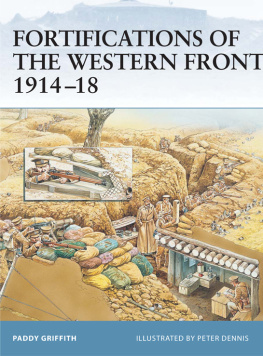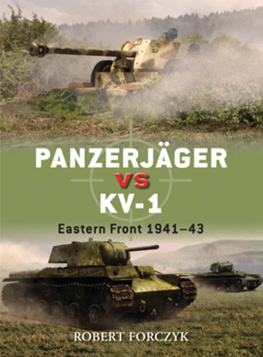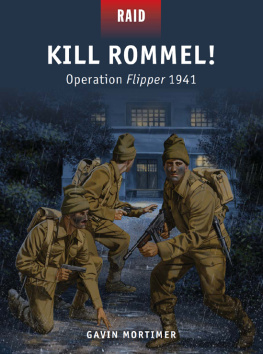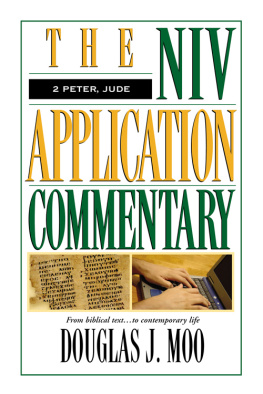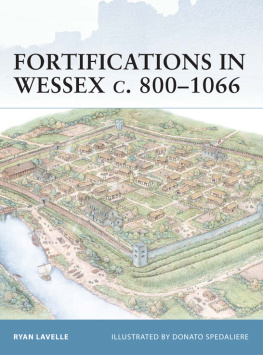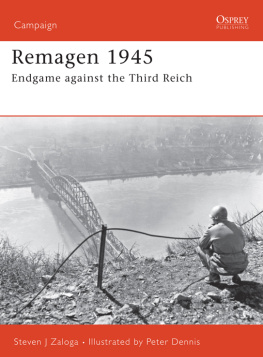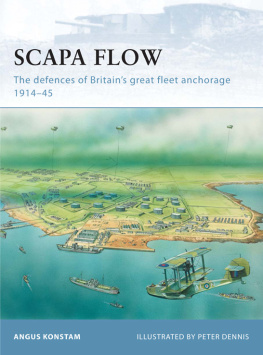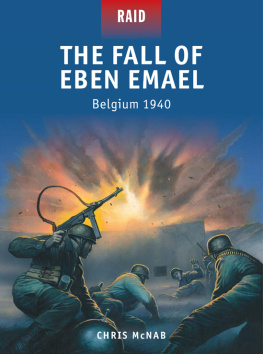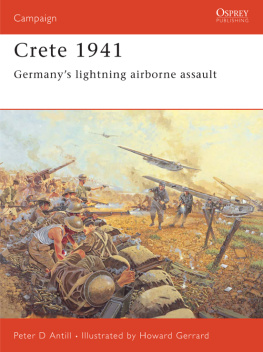Dennis Peter - Fortifications of the Western Front 1914-18
Here you can read online Dennis Peter - Fortifications of the Western Front 1914-18 full text of the book (entire story) in english for free. Download pdf and epub, get meaning, cover and reviews about this ebook. City: London, year: 2013, publisher: Osprey Publishing;Bloomsbury Publishing Plc, genre: History. Description of the work, (preface) as well as reviews are available. Best literature library LitArk.com created for fans of good reading and offers a wide selection of genres:
Romance novel
Science fiction
Adventure
Detective
Science
History
Home and family
Prose
Art
Politics
Computer
Non-fiction
Religion
Business
Children
Humor
Choose a favorite category and find really read worthwhile books. Enjoy immersion in the world of imagination, feel the emotions of the characters or learn something new for yourself, make an fascinating discovery.
- Book:Fortifications of the Western Front 1914-18
- Author:
- Publisher:Osprey Publishing;Bloomsbury Publishing Plc
- Genre:
- Year:2013
- City:London
- Rating:3 / 5
- Favourites:Add to favourites
- Your mark:
- 60
- 1
- 2
- 3
- 4
- 5
Fortifications of the Western Front 1914-18: summary, description and annotation
We offer to read an annotation, description, summary or preface (depends on what the author of the book "Fortifications of the Western Front 1914-18" wrote himself). If you haven't found the necessary information about the book — write in the comments, we will try to find it.
Fortifications of the Western Front 1914-18 — read online for free the complete book (whole text) full work
Below is the text of the book, divided by pages. System saving the place of the last page read, allows you to conveniently read the book "Fortifications of the Western Front 1914-18" online for free, without having to search again every time where you left off. Put a bookmark, and you can go to the page where you finished reading at any time.
Font size:
Interval:
Bookmark:
FORTRESS 24
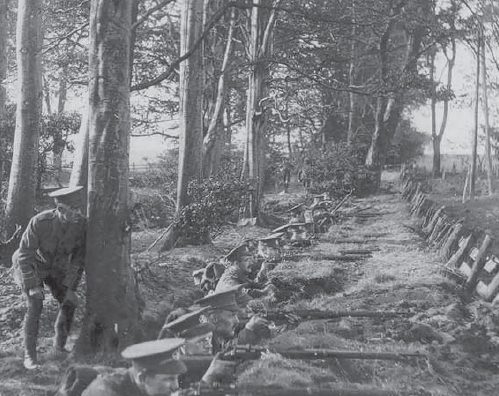
| PADDY GRIFFITH | ILLUSTRATED BY PETER DENNIS |
Series editors Marcus Cowper and Nikolai Bogdanovic
By 1914 there had been many major changes in weaponry since the 1860s, of which by far the most important was the replacement of black powder explosives (basic gunpowder) by a whole range of new low and especially high explosives (or HE). These not only enabled artillery to fire at a much greater range than previously, but, pound for pound, allowed each shell to deliver a far larger destructive punch. By about 1900 new recoil systems were also enabling a terrifically high rate of fire without any loss of accuracy.
The field gunners were at first reluctant to exploit their new capability to fire far beyond the position that could be observed directly from their gun sites. It took a long process of re-education for them to adapt to indirect, observed fire from hidden positions far from the enemy. Nevertheless, fire of this type was by far the most destructive element on the World War I battlefield. Not only could it devastate its entire target area within a few minutes, but the victim usually found it incredibly difficult to locate the guns that were doing the firing, let alone destroy them. The artillery could therefore kill without being killed, at least until the complex and specialised arts of long-range counter-battery (CB) fire could be perfected towards the end of the war. In these circumstances an artillery duel normally meant that the artilleries of both sides would be pummelling the long-suffering infantry; but no one very much would be pummelling them. Artillery caused around 60 per cent of the casualties in the war, which means it must have killed a total of around 6 million men. This was many more than the notorious machine guns, whose effect was far more localised in both place and time.
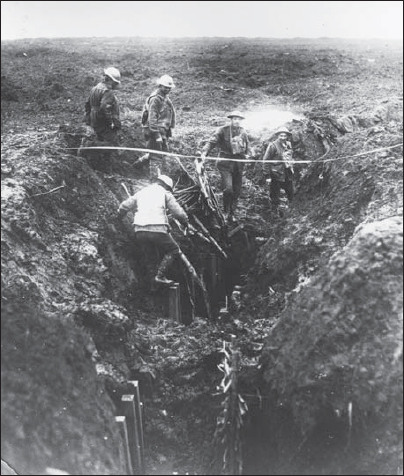
Australians improving poor German trenches at the Maze, Le Barque, on the Somme, 28 February 1917. Contrary to a widespread myth, many of the German trenches, especially those behind the front lines of July 1916, were just as shallow, shoddy and hastily built as the allied ones. The real strength of the fortifications on both sides lay in the dugouts below ground level. (Imperial War Museum, E 210)
Obviously the most urgent priority for infantry was to find counter-measures to HE shelling. Many different approaches were tried, such as dispersion, camouflage, screening and smoke; but as early as September 1914 it was already clear that there was really no substitute for digging. The casualty rate to men in the open was dramatically reduced if only they could throw themselves into even the shallowest ditch, scrape or crater. As soon as this happened there were two clear effects: the first was that despite many pre-war doctrinal denials the burrowing infantry would no longer be available for offensive action; and the second was that the artillery tormenting them would need a great deal more guns and shells to scour the area clear of opposition. The battle became a matter of attrition, as an increasingly numerous artillery tried to grind down an infantry force that was increasingly well dug in.
As mobile warfare faltered and died in the autumn of 1914, the two opposing lines became increasingly defined and permanent, and the trenches and dugouts that made up the lines became more elaborate. By the end of 1915 the Western Front could be considered as a series of semi-underground townships, each complete with a vast population and most of the amenities with the obvious exceptions of safety and comfort that could be found in the sprawling peacetime boroughs of the Black Country or the Ruhr. The population even included quite large numbers of women, most of them honest, very close behind the lines, although admittedly the gender ratio was unnaturally skewed heavily in favour of the males.
The strategy of the allies was essentially offensive, and their generals were worried that too much fortification would dull the aggressive edge of their troops. The Germans, by contrast, were concentrating most of their offensives on the Eastern Front and, apart from their attack on Verdun, were almost entirely defensive in the west until the spring of 1918. This gave them an incentive to continue perfecting their art of fortification almost to the end of the war. Already in the battle of the Somme in 1916 it was found that the German front trenches were better built, and their dugouts deeper and better protected, than the British ones although admittedly the rearward lines were still often shallow and poorly built. In their 1917 spring retreat the Germans added booby traps to the mix; then at Ypres they used innundations and concrete pillboxes in depth, while at Bullecourt and Cambrai the Hindenburg Line featured some amazingly dense hedges of barbed wire. Finally, by 1918, it had become routine for the Germans to include such novelties as anti-tank mines and guns in their defences.
The better the fortifications became, the harder it was to attack them. Whereas in 1914 a relatively small amount of artillery had been able to destroy all opposition in any given area, by 1917 it needed an incredibly large amount. Even then the object could no longer be to destroy the enemy, but only to neutralise him for long enough to allow friendly infantry to occupy the ground. This could sometimes be done very effectively, as it was in the initial British assaults on Arras, Messines and Cambrai in 1917; or in four of the German spring offensives in 1918. Nevertheless, such results were very difficult and laborious to organise, and it was still more difficult to bring forward the guns over broken ground to convert success on the first day into a further attack on the second. For most of the time, along most of the Westen Front, major assaults could not be attempted. Despite the awesome power of an attackers artillery, therefore, it was the fortifications and their defensive artillery that generally enjoyed the upper hand. This combination ensured that for most of the time the two sides sat and glowered at each other across no mans land. Successful offensives on the Western Front would be few and very costly, so that the war as a whole would forever be remembered for its indecisiveness, immobility and sickening sense of futility.
After the initial allied retreat in August 1914, then the Marne counter-attack and the race to the sea, the Western Front became established on essentially the line it would occupy until early 1917. Two years of insistent allied battering then persuaded the Germans to make a deliberate withdrawal along about 18 per cent of their frontage, to a shorter but stronger segment of line in their Hindenburg Position covering Cambrai and St Quentin. They held this line defensively until their major advances in the spring of 1918, after which the allies made still more dramatic counter-advances from July to the end of the war on 11 November.
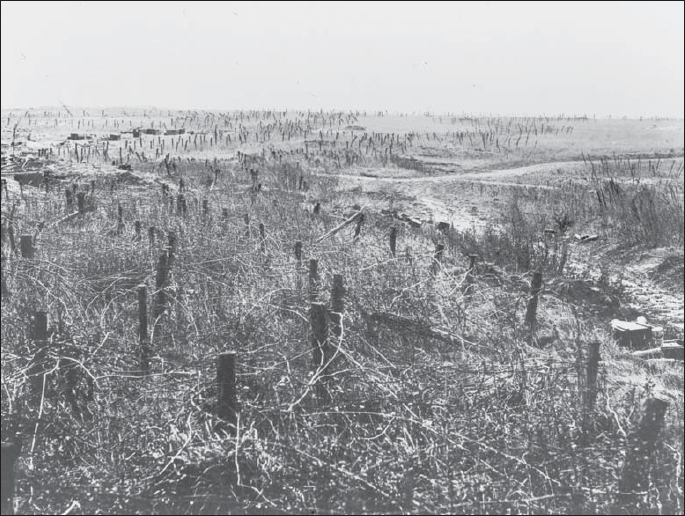
Thick wire in the Hindenburg Line at Masnires. (Imperial War Museum, E 3583)
The old Western Front of 1915 and 1916 ran from Nieuport, where the river Yser flows into the North Sea, inland through low-lying and badly drained clay land to the Ypres salient, which the British held throughout the war. Then it struck south through Messines and Armentires to Loos, still in the traditional British sector, and on around the western side of Lens to the chalk of Vimy Ridge and Arras an area which had originally been held by the French, but which was taken over by the rapidly expanding BEF in late 1915. From Arras the line went south again to the epic Anglo-French Somme battlefield of 1916, between Albert and Bapaume, then across the river Somme west of Pronne to skirt around the western side of Noyon, just north of Compigne. After that it turned sharply eastwards to join the line of the river Aisne around Soissons, putting the Germans into a clear salient at Noyon, which the French tried to pinch out in 191516, but which the Germans abandoned in 1917 during their retreat to the Hindenburg Line. French efforts in this area would then be expended against the long and deadly ridge of the
Next pageFont size:
Interval:
Bookmark:
Similar books «Fortifications of the Western Front 1914-18»
Look at similar books to Fortifications of the Western Front 1914-18. We have selected literature similar in name and meaning in the hope of providing readers with more options to find new, interesting, not yet read works.
Discussion, reviews of the book Fortifications of the Western Front 1914-18 and just readers' own opinions. Leave your comments, write what you think about the work, its meaning or the main characters. Specify what exactly you liked and what you didn't like, and why you think so.

